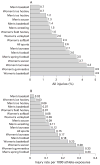Non-contact ACL injuries in female athletes: an International Olympic Committee current concepts statement
- PMID: 18539658
- PMCID: PMC3920910
- DOI: 10.1136/bjsm.2008.048934
Non-contact ACL injuries in female athletes: an International Olympic Committee current concepts statement
Abstract
The incidence of anterior cruciate ligament (ACL) injury remains high in young athletes. Because female athletes have a much higher incidence of ACL injuries in sports such as basketball and team handball than male athletes, the IOC Medical Commission invited a multidisciplinary group of ACL expert clinicians and scientists to (1) review current evidence including data from the new Scandinavian ACL registries; (2) critically evaluate high-quality studies of injury mechanics; (3) consider the key elements of successful prevention programmes; (4) summarise clinical management including surgery and conservative management; and (5) identify areas for further research. Risk factors for female athletes suffering ACL injury include: (1) being in the preovulatory phase of the menstrual cycle compared with the postovulatory phase; (2) having decreased intercondylar notch width on plain radiography; and (3) developing increased knee abduction moment (a valgus intersegmental torque) during impact on landing. Well-designed injury prevention programmes reduce the risk of ACL for athletes, particularly women. These programmes attempt to alter dynamic loading of the tibiofemoral joint through neuromuscular and proprioceptive training. They emphasise proper landing and cutting techniques. This includes landing softly on the forefoot and rolling back to the rearfoot, engaging knee and hip flexion and, where possible, landing on two feet. Players are trained to avoid excessive dynamic valgus of the knee and to focus on the "knee over toe position" when cutting.
Conflict of interest statement
Figures




References
-
- Granan LP, Bahr R, Steindal K, et al. Development of a national cruciate ligament surgery registry: the Norwegian National Knee Ligament Registry. Am J Sports Med. 2008;36:308–15. - PubMed
-
- Lobenhoffer P. Injuries of the knee ligaments. II. Surgical therapy of anterior and posterior knee instability. Chirurg. 1999;70:326–38. - PubMed
-
- Arendt E, Dick R. Knee injury patterns among men and women in collegiate basketball and soccer: NCAA data and review of literature. Am J Sports Med. 1995;23:694–701. - PubMed
-
- Johnson R. The ACL injury in Alpine skiing: the mechanism and epidemiology. Aviemore, UK: International Society of Skiing Safety; May, 2007.
Publication types
MeSH terms
Grants and funding
LinkOut - more resources
Full Text Sources
Medical
